CONTENTS
INTRODUCTION
This is one of the few Bridge books aimed at the social or less experienced player, as opposed to the tournament player. If you long to improve, but find yourself repeating the same mistakes and perhaps not even knowing that they are mistakes, then this book is for you.
In the short opening section, The Game, I set out the keys to holding your head up high at the Bridge table. Incorporated into each of the three subsections Bidding, Declarer Play, Defence are all the tips. Each tip is numbered, enabling you to cross-reference it with the relevant deal in the main body of the book.
The pages that follow are based on my Friday column in The Times, entitled Common Mistakes for the Less Experienced. Each page contains an instructive deal and a salutary lesson: what happened when the hand was played at the table, and what should have happened. The analysis ends with the numbered tip.
You can read The Game first, in its entirety. Or you can flick back and forth from the numbered tip in The Game to its deal in the main body of the book. Alternatively you can pick a deal at random, with the option of cross-referencing each tip in The Game.
I hope you enjoy the book and find it instructive. If you are not a regular Times reader, you can access my daily column from The Times online www.timesonline.co.uk. For more information about myself and my Bridge School in South West London see www.andrewrobson.co.uk.
THE GAME
Bridge is the most widely played game in the world, and surely the best. It is endlessly fascinating at whatever level it is played, from complete beginner up to world champion. Even experts never truly conquer the game a blessing, or Bridge would go the way of Noughts and Crosses. As if to emphasize this, Computer Bridge is lagging behind Computer Chess or Backgammon. The skills required to be a top Bridge player are so many and varied.
A microcosm of life, Bridge combines competition (against the opponents) and co-operation (with partner). Perhaps the single most important joy of the game is this partnership element. From the moment you pick up your 13 cards to form your hand, you try to convey messages to partner about it. This communication of information in the first phase of the game the bidding (or auction) leads to one partnership (the one making the final higher bid) contracting to make a designated number of tricks in their chosen trump suit. Then the play begins will they prevail, or will they be prevented from achieving their trick target? A few minutes later, a totally new deal begins and with it a whole new set of challenges.
SECTION 1: Bidding
INTRODUCTION I will be teaching a simple version of English Standard Acol, incorporating a 1214 Weak notrump and Four-Card Majors. I have focussed primarily on the first stages of an auction: if the first few bids are accurate, a sensible contract will normally be reached.
THE BASICS When first looking at your hand, count the high-card points (ace = four; king = three; queen = two; jack = one). An average hand will contain ten points (an ace, a king, a queen and a jack). Also look at your distribution. Are your suits of relatively similar length (balanced), or is there some disparity (unbalanced)?
You must then try to describe your hand to partner during the first phase of Bridge: the bidding (or auction). There are two objectives of the bidding: you must ascertain (i) whether you have a mutually compatible trump suit, a fit (eight or more cards in one suit between the partnership), and (ii) how many of the 13 tricks for which to aim with that suit as trumps. Bids must increase, starting from 1 then 1
then 1 , 1
, 1 , 1
, 1 , 1 notrump (NT), 2
, 1 notrump (NT), 2 , 2
, 2 .7NT. Adding six to the number of the bid made tells you the number of tricks for which you have contracted. Thus 3
.7NT. Adding six to the number of the bid made tells you the number of tricks for which you have contracted. Thus 3 means that you must win nine tricks (or more) with clubs as trumps.
means that you must win nine tricks (or more) with clubs as trumps.
Clubs and diamonds are known collectively as the minor suits. They score 20 points each trick (over the six), so bidding and making 5 and 5
and 5 is required to score game (100 points). Hearts and spades, the majors, score at 30 points each, so 4
is required to score game (100 points). Hearts and spades, the majors, score at 30 points each, so 4 and 4
and 4 win game. Notrumps literally playing without a trump suit score slightly more than the suits: 40 for the first trick (over six), reverting to 30. Thus 2NT scores 70 points and 3NT gives game. The three most attractive game contracts are 3NT, 4
win game. Notrumps literally playing without a trump suit score slightly more than the suits: 40 for the first trick (over six), reverting to 30. Thus 2NT scores 70 points and 3NT gives game. The three most attractive game contracts are 3NT, 4 and 4
and 4 . Holding 25 high-card points between the partnership is a good guide for attempting one of those games. After winning the game, you become vulnerable: half way to rubber (the first side to two games). If you now fail in a contract, your opponents receive 100 per trick as opposed to 50. Playing Duplicate Bridge (or Chicago four deal Bridge) a bonus is given for making a game: 300 (non-vulnerable) and 500 (vulnerable). In Duplicate an extra 50 points is added to the score resulting from a making part-score. Thus Four Hearts bid and made (non-vulnerable) scores 300 (the non-vulnerable game bonus) + 120 (the tricks) = 420. Two Hearts making three (i.e. one overtrick) scores 50 (part-score bonus) + 90 (tricks made) = 140. Note that overtricks score at trick value (i.e. 30 a trick for notrumps and majors; 20 for minors).
. Holding 25 high-card points between the partnership is a good guide for attempting one of those games. After winning the game, you become vulnerable: half way to rubber (the first side to two games). If you now fail in a contract, your opponents receive 100 per trick as opposed to 50. Playing Duplicate Bridge (or Chicago four deal Bridge) a bonus is given for making a game: 300 (non-vulnerable) and 500 (vulnerable). In Duplicate an extra 50 points is added to the score resulting from a making part-score. Thus Four Hearts bid and made (non-vulnerable) scores 300 (the non-vulnerable game bonus) + 120 (the tricks) = 420. Two Hearts making three (i.e. one overtrick) scores 50 (part-score bonus) + 90 (tricks made) = 140. Note that overtricks score at trick value (i.e. 30 a trick for notrumps and majors; 20 for minors).
OPENING THE BIDDING Dealer starts the bidding. If he has a bad hand, he does not open the bidding, instead saying No Bid or Pass. If he has a little above average or better, he opens. Typically he will open One of his Longest Suit.
Question: What is a little above average?
Answer: Always open the bidding with 12 or more points. You should also open when holding slightly less with a useful shape. Use The Rule of 20, which states that you should open when the number of cards in your two longest suits added to your high-card points totals 20 or more ().
With a choice of two equal length suits, open the higher ranking ().
NOTRUMPS That you can win game in notrumps with just nine tricks gives it a huge significance and arguably the most important opening bid (and perhaps the most common) is 1NT. This shows a balanced hand and 12, 13 or 14 points.
Question: What precisely is a balanced hand?
Answer: It is a hand with no void (a suit with no cards), no singleton (a suit with one card), and at most one doubleton (two cards). There are just three balanced distributions: 4432, 4333 and 5332.
With one of the above shapes and 1214 points, you MUST open 1NT ().
RESPONDING TO ONE NOTRUMP When responding to partners 1NT opener, bear in mind that, because you know so much about partners hand, you as responder are in charge. Partner will not bid again unless you make a strong bid. Although there will be occasions where responder needs more information, essentially the basic principle is:

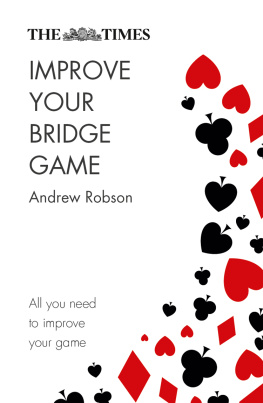
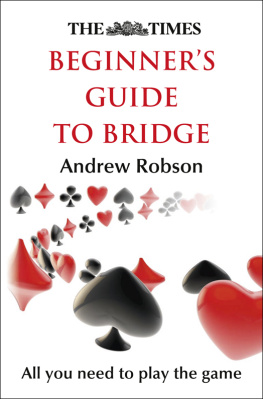
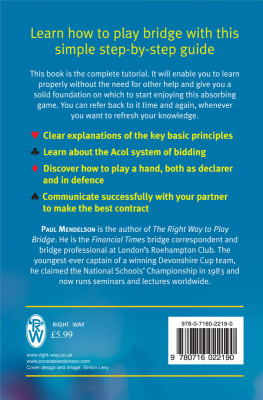

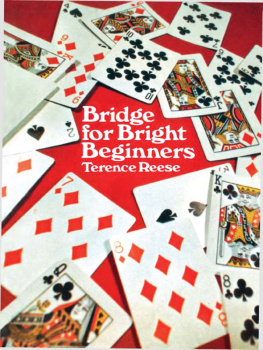
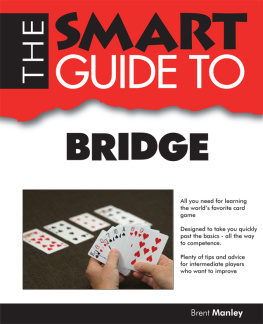

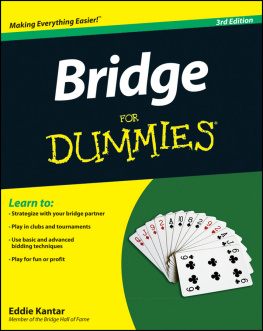
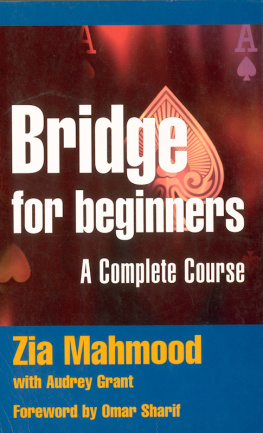
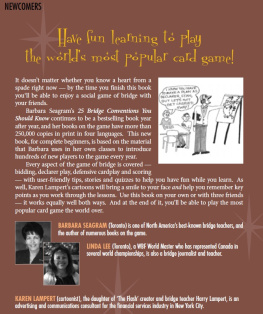
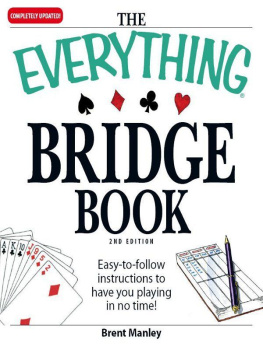
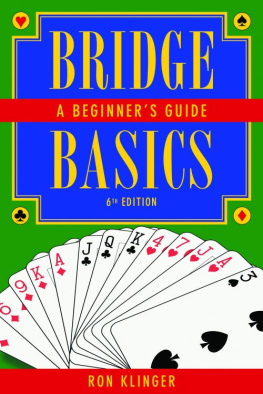
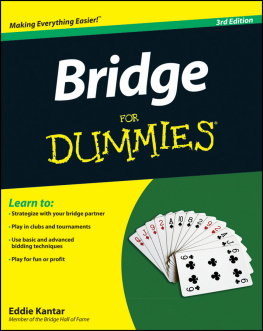
 then 1
then 1 , 1
, 1 , 1
, 1 , 1 notrump (NT), 2
, 1 notrump (NT), 2 and 4
and 4